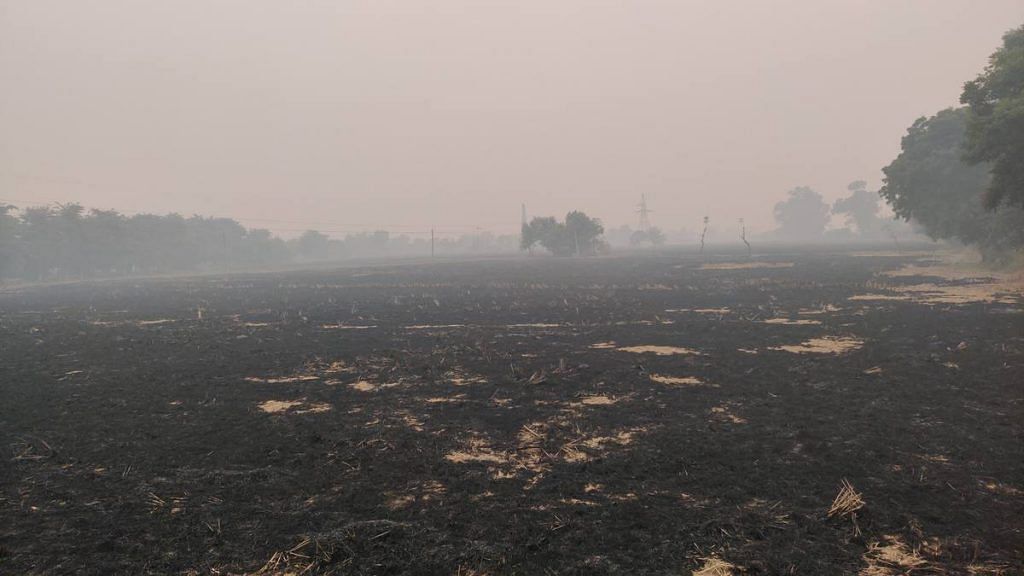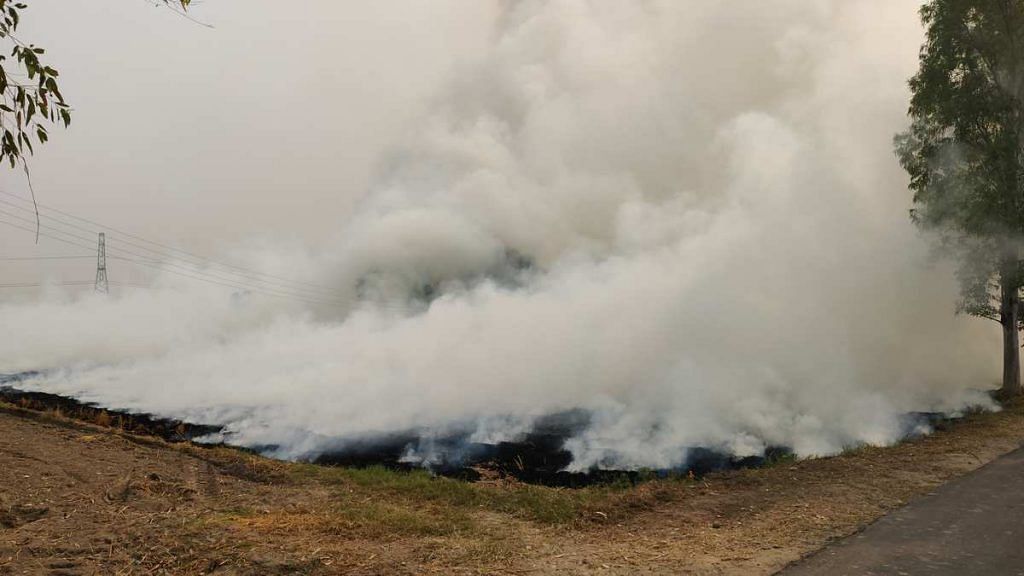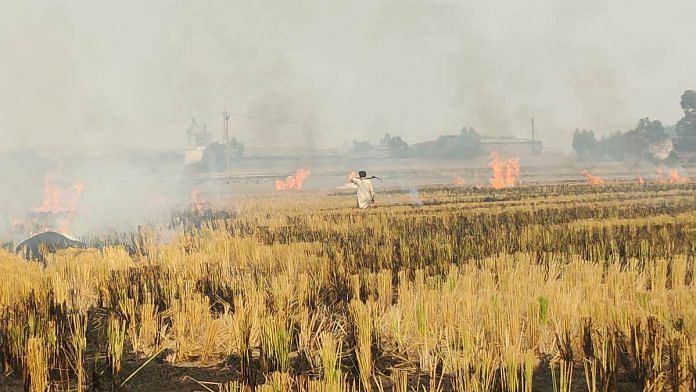Sangrur/Patiala: His eyes watering from the smoke billowing around him and charred paddy stubble at his feet, the farmer, from Gobindpura village in Punjab’s Sangrur district, is not in the mood to listen to a lecture.
“Stubble burning is very harmful, we know this,” he said, moments after lighting a fire. “But we don’t have an option. We don’t have any resources. The government only talks but doesn’t help.” He declined to give his name before walking into the hazy distance.
Going by satellite images, Sangrur has recorded the highest incidence of stubble burning in Punjab this season, but it is hardly an isolated case.
As one enters Punjab from Haryana on the national highway, the scene on either side of the road resembles a pastoral apocalypse — black fields, flashes of fire, smoky skies — much before approaching Sangrur district, home constituency of Chief Minister Bhagwant Mann.
Between 15 September and 1 November, Punjab registered 17,846 events of residue burning, according to satellite data from ICAR-Indian Agricultural Research Institute. That’s 18.5 per cent more than last year in the same period.
Compared to Punjab, other states that have recorded “active fire events due to rice residue burning” this season are lightweights — while there were 2,083 incidents in Haryana, Uttar Pradesh, Rajasthan, and Madhya Pradesh had 777, 345 and 972, respectively.
Punjab Tuesday alone registered a total of 1,842 rice residue burning incidents, having recorded over 2,000 fires on two of the five previous days. Within the state, two of the worst offenders, so to speak, are Sangrur and Patiala districts.

Compared to the same period last year, Sangrur has seen a 137 per cent increase in farm fires, while for Patiala it has been a 70 per cent rise.
So, what gives? When ThePrint visited the two districts, it was clear that farmers, via various awareness campaigns, are cognisant of the ill-effects of stubble burning, including pollution. However, it isn’t enough of an incentive to inspire a behaviour change, they say, given that alternative methods to dispose of stubble are more expensive.
Agriculture Department officials on the ground, meanwhile, claim that it is nearly impossible to enforce rules and that they have become scapegoats because of lack of political will and inaction from higher authorities.
Also read: Why Punjab farmers who bet big on moong this summer reaped a harvest of discontent
‘How can we not try to save money?’
Hard at work since 6 in the morning, his arms and legs blackened with soot, Sangrur farmer Gurmeet Singh dreams of one day moving to Canada. He has a postgraduate degree, which might improve his prospects, he believes.
However, when it comes to clearing fields of paddy residue and readying them for the next round of seeding, modern alternatives do not work for him. The biggest reason? Cost.
“If we start investing in machinery to avoid burning, all our investment will go into that,” he said, adding that the prices of labour and diesel are also prohibitive. “As it is, we are barely making any profit. We have to sit for protests to safeguard ourselves from the government.”
Gurminder Singh, a farmer in Patiala, feels that stubble burning can only stop if everyone is provided with a seeder — machines that can uproot the stubble and also sow seeds in the cleared land.
“Farmers are the first people to be affected by the pollution caused by stubble burning but we are already running in losses, how can we not try to save money? If we all get super seeders, no one will burn stubble.”
Some Agriculture Department officials, however, claim that seeders have been subsidised for farmers and there has been some uptake. The government also provides super seeders to farmers on a rotational basis in various districts.
“We have given machinery worth Rs 15-20 crore with subsidies to the farmers this season. This includes super seeders, happy seeders, among others,” said Dr Amarjeet Singh, Agriculture Department officer from Sangrur.
He insists the situation in the district is not as bad as it is being made out to be. “If seen in terms of percentage of cultivated land, Sangrur does not have the highest number of incidents of stubble burning. Sangrur has 2,91,000 hectares of cultivated land,” he said.
The chief agriculture officer in Patiala, Dr Harinder Singh, acknowledges that price is the main barrier.
“If one uses alternative methods of eliminating stubble, the cost for the farmer increases by nearly Rs 3,000 per acre,” he said.

However, according to him, it is expected that by the end of the season, Patiala would have fared better than it did last year. “We still expect a 50 per cent reduction in the stubble-burning incidents compared to last year in Patiala. Over 80 per cent of the harvesting is done.”
Another possible alternative to stubble burning that farmers have been apprised of, Amarjeet said, is bio-decomposing, a process that turns crop residue into manure within two to three weeks. But this, for many farmers, is too long a gap before sowing the next crop.
Then there is the option of cutting the stubble and making bales out of them. But while this method has few costs other than transportation, the industries that use these bales, like bio-thermal power plants or bio oil producers, aren’t found everywhere.
However, he admitted that beyond spreading awareness among farmers, there is not much that officials like him can do in terms of ensuring compliance.
Patiala’s Harinder Singh agreed. “The problem is that we can’t take any punitive action and thus it becomes difficult for us to control such incidents,” he said.
‘Government wants change, but no action can be taken against farmers’
Amid a blame-game between the Punjab government and the central government, Agriculture Department officials claim they have become fall guys since no one wants to take any action against farmers.
The Punjab government has taken harsh action against Agriculture Department officials in the wake of stubble burning incidents, suspending several Sunday for alleged dereliction of duty, including the chief agriculture officer of Sangrur, Harbans Singh.
Other officials ThePrint spoke to said they believed this was unfair, and blamed “politics” and stubborn farmers’ unions for the state of affairs.
“Our job is to spread awareness. We have organised camps, gone on ground to meet people from time to time. But it is the pollution board that can take action,” said Amarjeet Singh.
“We are stuck in the middle,” said another senior official from the Agriculture Department in Patiala. “The government wants change but there is no action that can be taken against the farmers.”
This official was also upset about the suspension of his colleagues. “We work very hard and still get suspensions. If we don’t have any power to take action, how can we bring change? The game of politics and vote-bank is the barrier for change,” the official added.
According to him, the central government’s repeal of the three farm laws in the wake of farmers’ protests has emboldened farm unions. “Many times when we go into fields, farmers surround us and don’t let us go. We have to seek police’s help to go back,” the Patiala official said.
A slow shift in mindset
The older generation is set in its ways, but there is hope yet for younger farmers, said Dr. Hardeep Singh Sabhikhi, assistant professor at Patiala’s Krishi Vigyan Kendra, a part of the National Agricultural Research System (NARS).
“No doubt there are difficulties in convincing farmers to stop stubble burning. But the younger generation is ready to embrace newer methods to stop it. There is a positive change in the mindset,” he said.
The government is also trying to promote self-help groups that can pool in their resources to purchase machinery, he added, which is getting some traction among younger farmers at least.
“Earlier, farmers were not even ready to listen but now some of the younger ones come forward to ask about ways in which they can stop stubble burning,” Hardeep said. “There are cases when elders of a family confront us against change during awareness camps. But when the camps get over, younger famers of the same family come to understand the alternatives to stubble burning.”
(Edited by Asavari Singh)
Also read: Cash sops, machine subsidies & more — why nothing has helped stop stubble burning in Punjab



